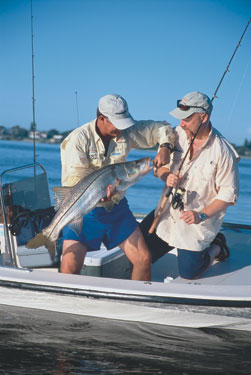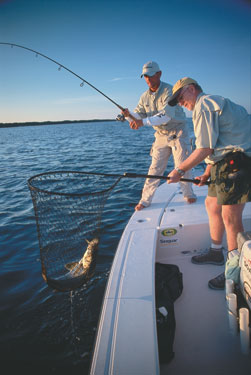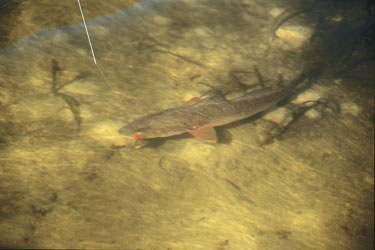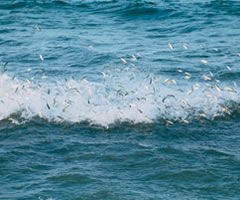September 24, 2013
By Larry Larsen
A simple, all-season plan for catching redfish, snook, trout and flounder on artificial lures.

Monster snook, like this 24-pounder, often strike near mullet schools.
|
“Here they come! They're pushing this way,” the captain excitedly warns us. “Look at their black backs right at the surface. They are heading right for us. Wait until they close in.”
No, we weren't sight-fishing for schools of bull reds or tarpon. In fact, we weren't even observing a sportfish or our intended quarry. It was a school of about 100 mullet moving toward our flats boat, black mullet in fact.
Nevertheless, Capt. Geoff Page was very excited about his discovery of the “pushing” mullet in the 3-foot-deep flats on the Indian River. He anticipated a bounty within that school that would excite all of us. As instructed, I waited for the school to move within casting range and then lofted my jig and green shad tail to the edge of the school. I started to slowly jig the 1/8-ounce bait back to our boat when a fish pounced on it and took off as I swept the rod into a hookset.
The trout—4 pounds, 12 ounces—was a nice fish and similar in size to one I had taken earlier. I was hoping for a larger snook, like the 10-pounder Page had taken from the previous school of mullet to which we had cast. His fish took a jerkbait out of a trough about a foot deeper than the surrounding grassflat. In the following two hours, we found four or five more mullet schools and took additional trout, jacks, bluefish and other species from the “muds” they were creating.
Page was born and raised in Sarasota and often fished the numerous inshore docks as a young man. He commercially gillnetted in the early '80s and sport-fished primarily with live shrimp until the early '90s. It was when an avid artificial bait tosser got Geoff into fishing jigs and soft plastics. He was hooked. In 1999 he began guiding, tapping knowledge he'd gained both as a commercial fisherman and sport fisherman.
As a gill netter, Page often noticed that redfish and other gamefish were mixed in with the mullet. Over the years since, he has developed his “It's all about the mullet” theory, which has proven successful on Intracoastal waters all over Florida. He effectively utilizes the technique to find redfish, trout, snook and flounder in waters no deeper than four feet.
“On both coasts of the state, we have three types of mullet,” Page explains. “We have a silver (or white) mullet, which never get much bigger than a foot long and maybe one and one-half pounds. We also have what everyone views as baitfish, and they are called finger mullet, which can grow to be small white or black mullet or the fantail mullet. The black mullet is the one that we always see jumping and splashing.”

One stragegy for taking advantage of the mullet run is to plug shorelines where mullet travel.
|
Black mullet, also called striped mullet, have bluish-gray or green backs shading to silver on the sides with distinct horizontal black barrings and white bellies. Their fins are lightly scaled at the base and unscaled above, and their noses are blunt. The fish migrate offshore to spawn and fry produced then move back inshore, far up tidal creeks. The adults follow the fry inshore where they resume feeding on algae and small marine lifeforms.
“Sometimes the late fall mullet get so big and push so much water that the uninformed believe they are a school of redfish moving across a flat,” Page said, laughing, “The ones that fill up with roe in November and December (between Tampa Bay and Charlotte Harbor) can get up to 7 or 8 pounds. A black mullet adult probably averages 3 1/2 to 4 pounds year-round. The females with the blood-streaked yellow roe are always the biggest mullet.”
In the summer, black mullet scatter and the schools are smaller. There could be only 30 to 40 fish in an average size school then, according to Page, but there may be 20 or 30 bunches of them on a large flat. In the fall, the schools may go from 100 pounds of fish (30 fish at 3 1/2 pounds each) to massive 2,000-pound schools having maybe 400 individual fish. As a result, the cooler months from November through March are often the best times to follow the mullet.

Mullet runs like this often produce a snook catch like this.
|
“During the summer, there are also lots of whitebait, pilchards, glass minnows and shiners around for the gamefish to eat,” he pointed out. “In late fall and winter, the fish will eat what is down in the mud. The mullet will churn up the morsels and the reds and snook come to feed.”
Page prefers fishing negative low tides in the winter. When the waters are from a minus 0.5 foot to a minus one foot below the mean low tide level specified on the charts, the time is perfect for locating mullet and sportfish. Most of the water is off the flats, making it easy to find mullet. With the low water, fish pull into troughs and potholes. Some of Page's favorite backcountry spots on the southwest coast are Bull Bay, Turtle Bay, Whidden Creek and Catfish Creek in Charlotte Harbor and Palma Sola Bay and Long Bar in Sarasota Bay.
“If the wind is from the north, the low tides will be even lower and better,” he says. “On the west coast, the north wind normally pushes the water out of the shallow flats and a south wind pushes water in. With that cold air coming in, the mud holes that are the warmest spots on the flats are fish magnets. With those conditions on an average day, we can catch 20 redfish, 20 trout and, if the water is not too cold, a dozen nice snook from these spots. I have had days where three of us pulled 60 redfish from 10 of these mullet-laden holes.”
During summer on the higher tides, mullet will push on up into the mangroves, and they are more difficult to locate and fish. Falling water, however, will pull them out of the bushes into areas they can stay in and wait for the return of the high tide. In the winter, the tides seldom get high enough to pose such problems. The mullet and gamefish following them won't be able to swim up under the mangrove bushes. The mullet are sentenced to stay out on the flats.
Locating Black Mullet
To locate black mullet on a flat, Page scans the surface near mangroves, sand potholes, troughs or other irregular topography. He'll look for jumping fish, swirls or splashing during tidal movement in either direction. The mullet will be “walking down the line,” as Page likes to term their movement, as one jumps and then another does the same thing and then another takes to the skies.
Often, in the winter months, Page will keep rods in the holders until he spots the mullet schools. When the mullet are full of roe, he will not fish until he locates a 1,000-pound school visually. He might cruise the flats in his boat until he sees 10 to 20 fish in the air at one time. Then, he can almost be assured of catching reds, snook and/or big trout in that school.
In slack water, they may not jump as much, so they can be more difficult to spot. When the wind is howling and the water is white capping, mullet are very difficult to see. If the water is clean, the sun is up and there is only a slight ripple on the surface, it is easier to see their big bodies pushing water. You can also distinguish between silver and the black mullet once you see them.
“When I work a series of potholes, a shoreline with a trench or any other place with mucky, soft bottom, I'm looking for black mullet,” says Geoff. “The mullet like to get in those places to feed on the plankton, and if there are 30 or more present, they are always moving and tailing as they grub and turn up the bottom through the area. The snook, redfish, larger trout and flounder will get right in there with the mullet and feed on the oyster crabs, slugs, crustaceans and grass shrimp kicked up.”

Redfish wait in mullet migration lanes to ambush their meal.
|
“When you are on a grassflat bar with a distinct edge and the minnows are in the same area as the mullet, that is the very best condition,” he says. “If the bottom goes from one foot down to three foot, that would be perfect.”
How Fish Relate to Mullet
If mullet are pushing over an extremely shallow sand-and-grass bar as they often do in low light, you won't find large redfish. They would be much more visible if they were present. Any redfish in the area will lay off that edge a little and wait for the mullet to move into slightly deeper water so that they can get under the school and feed on what is turned up, according to Page.
“I like to throw into the middle or outside edge of the school of mullet with a 1/8- or 1/4-ounce jerkbait, let it fall to the bottom, and then jig it back very slowly trying to puff the sand,” he explains. “The redfish or snook will be there to see the disturbance and feed on the bait. They are usually either tracking right with the mullet if the school is making lots of turns, or they will be just behind them if the mullet are moving in a relatively straight path. If the mullet are sticking to different sand holes, the reds and snook may be just on the edges.

Witnessing a school of mullet in a state like this means you're in the zone.
|
“Larger trout behave similar to redfish and snook near the schools of mullet, but small trout aren't interested in being around the muds,” he adds. “I believe that they are afraid of being eaten by the larger snook and reds if they are mixed in with the mullet. In the past three years, I've caught several 7- to 9-pound trout from the muds on the flats of the Indian River.”
In the Mosquito Lagoon at Titusville, Page and a friend came across a muddy trough with a series of white sand holes in extremely shallow water. The wind had blown all the water out of the lagoon, but Geoff discovered a 200-yard area just a foot deeper than the rest of the flat. It was full of mullet and redfish. The two anglers each tossed a soft-plastic glow shrimp with an 1/8-ounce slip sinker ahead of it to keep it down in the mud and the mullet. They caught 60 reds up to 9 pounds in two days.
In Pine Island Sound, big pushes of mullet move across the tall turtlegrass and tailing reds will move in behind them. With minimal sand holes available, the forage cling to the grass, and the quality-size reds follow the mullet schools and clean up what they tear up. In these conditions, you have to rig weedless, according to the guide. He uses a 5/0 offset hook, sans weight, and rigs a slow-falling jerkbait weedless, Texas-style. Another effective option in the grass is jiggling a soft-plastic shrimp rigged backwards with a rattle in its nose and a weedless hook in the tail.
In winter, darker-color baits seem more productive. Root beer, avocado/red glitter and the alewife are all prime hues for success then. The green, gold glitter and rainbow trout colors in both jerkbaits and shad tails are effective most of the rest of the year, according to Page.
Most people see a mullet jumping and their comments are, “Oh, it's only a school of mullet” or “They won't hit a lure, so let's not waste time here.” The average angler won't put two-and-two together to understand that their target species might be mixed right in with the mullet. Even experienced anglers and guides often overlook the mullet factor. You shouldn't!
Originally published in Florida Sportsman, December, 2005.
Click Here to Have Florida Sportsman Magazine Delivered to Your Home.
